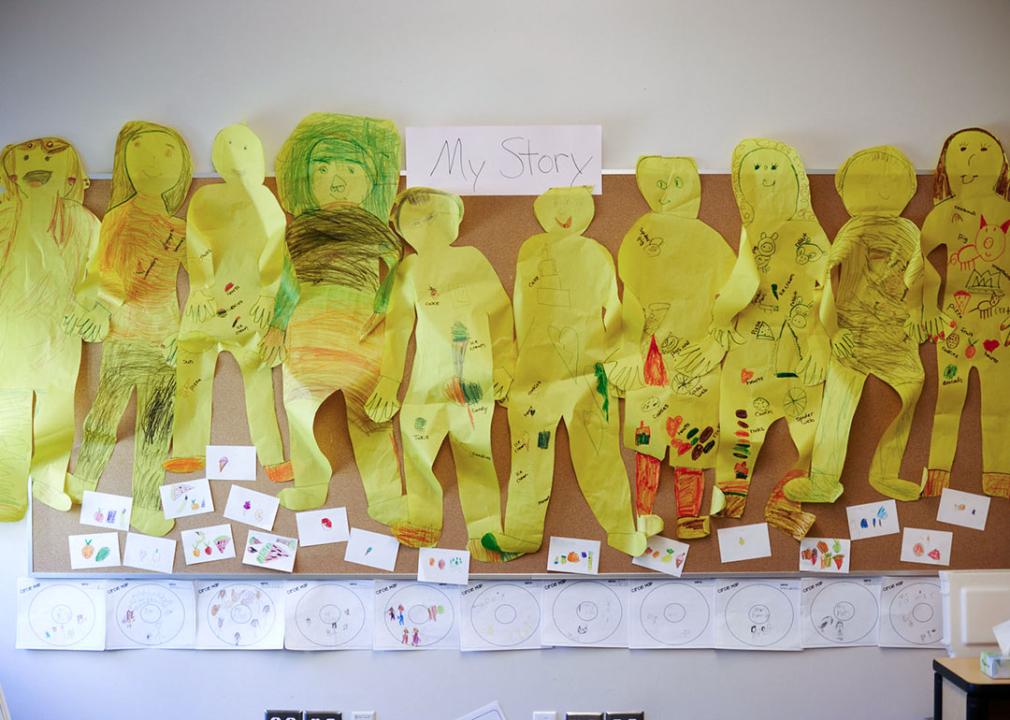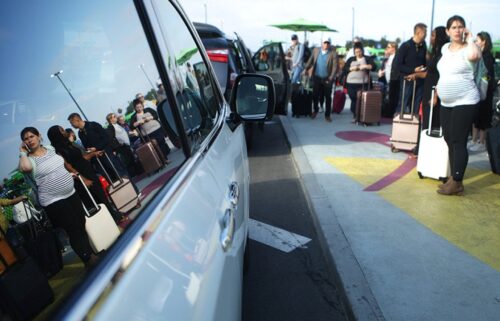Coalition maintains undocumented kids have a right to attend public schools

Jimena Peck for Chalkbeat
Coalition maintains undocumented kids have a right to attend public schools
Display of student artwork at Josephine Hodgkins Leadership Academy in Denver, Colorado.
A new coalition is on high alert for violations of a landmark Supreme Court ruling that guarantees children the right to a free public education regardless of their immigration status.
Known as Education for All, the campaign is working to counteract anti-immigrant rhetoric and conservative policy proposals seeking to limit the educational rights of undocumented children, which are protected by the 1982 Supreme Court decision Plyler v. Doe.
The campaign, which launched in May, comes as The Heritage Foundation, a think tank with ties to former President Donald Trump, is pushing states to charge undocumented children tuition to attend public school. Doing so, Heritage says, could lead the Supreme Court to reconsider the Plyler ruling.
Supporters of the idea say the costs of educating undocumented children have grown too high and that migrant students are drawing resources from U.S. citizens. Critics argue these policies would deny hundreds of thousands of kids the fundamental right to an education — and send shockwaves through the nation’s economy, social safety net, and criminal justice system.
Chalkbeat reports that lawmakers in at least four states have tried to pass such measures since 2022. Already, some districts have thrown up barriers that prevent newcomers from enrolling, while some school board members have suggested collecting data on students’ immigration status.
“We want to take everything seriously,” said Will Dempster, the vice president of strategic communications for the National Immigration Law Center, which is leading the coalition. “They’re testing the boundaries of what’s possible.”
Three dozen organizations have joined the coalition, including immigrant rights groups, education and legal advocates, and the nation’s two largest teachers unions. Their work spans border states like Arizona and Texas, and states that have enrolled a large share of migrant students in recent years, such as New York, California, Colorado, and Illinois.
Together they will be watchdogging school board meetings, lobbying state lawmakers, educating families about their rights, and making sure school officials understand the Plyler decision. The goal is to “coordinate when things pop up in different states and be ready to mobilize,” Dempster said.
Amid cost concerns, schools support migrant students
The coalition is also pushing back against claims from Trump and other conservative politicians about newly arrived migrant children.
“They’re taking over our schools,” Trump said last month during the presidential debate. Earlier this year, Trump falsely claimed that migrant children had displaced other students in New York City schools, though the district actually has empty seats it’s trying to fill.
Similarly, in June, U.S. Rep. Aaron Bean, a Florida Republican, held an education hearing titled “The Consequences of Biden’s Border Chaos for K-12 Schools” where he spoke about the “staggering” cost of educating undocumented kids.
“Educating illegal immigrant children requires substantial resources, altering the learning environment for all students,” Bean said. “Overcrowded classrooms, the need for new facilities, and strained student-to-teacher ratios are just some of the challenges.”
He pointed to Colorado giving schools an extra $24 million this year to help offset the costs of educating newcomer students, and a pair of schools in Austin, Texas, where teachers taught classes in hallways after a big uptick in refugee students.
Some schools have struggled to meet the needs of newly arrived immigrant students. That’s often because they do not have enough bilingual staff or receive limited funding to educate immigrant students.
In 2022, Texas Gov. Greg Abbott said the Plyler ruling should be revisited “because the expenses are extraordinary” and he called on the federal government to pay states’ costs. A lawmaker in his state tried to bar undocumented children from enrolling in public schools unless the federal government did just that, but the bill didn’t go anywhere.
Similar proposals were floated in Utah, Oklahoma, and Tennessee, but none passed — suggesting the idea remains controversial, even among conservatives.
Newly arrived students’ needs aren’t unique. Many U.S.-born children also need language support, trauma-informed counseling, or help catching up after interrupted schooling. And some schools have stepped up by training staff to provide additional mental health support or adding summer programs to help kids adjust to life in the U.S.
The coalition plans to highlight the many benefits immigrant students can bring to their classmates and school communities, too.
“Part of what we can do is show that immigrant students can succeed when given the right support,” said Liza Schwartzwald, the director of economic justice and family empowerment at the New York Immigration Coalition, which belongs to Education for All. “These are not kids that are throwing our education system into turmoil.”
Enrollment barriers, data collection could violate student rights
Still, even without official state restrictions, undocumented children commonly face barriers to school enrollment, including in Democratic-led states.
- Last summer, New York’s attorney general said the state had learned of school policies that made it “difficult or impossible” for undocumented students to enroll — likely in violation of state or federal protections. Some districts required students or their parents to provide voter registration cards, which aren’t available to non-citizens, or threatened to make home visits if a student couldn’t establish residency with a lease, which can be difficult for undocumented families to obtain.
- Throughout New York City, newly arrived immigrant youth have encountered wait lists or been told there are no spots as they sought to enroll in school, City Limits reported. On the flip side, some newcomer high schoolers have been pressured to leave their school when they needed more support to graduate.
- In Massachusetts, some districts said they didn’t plan to enroll migrant children who were housed in temporary shelters, until the state told them they had to.
- Hundreds of schools in dozens of states recently told The 74 they wouldn’t admit a 19-year-old Venezuelan student with limited English skills, even though he was legally entitled to enroll.
Coalition members are alert to these and other examples of schools potentially violating the rights laid out in Plyler.
Alejandra Vázquez Baur, who directs the National Newcomer Network, which includes 250 teachers, school leaders, community advocates, and researchers from across the country, said members share possible infringements when they meet every other month.
Her organization has filed federal civil rights complaints on behalf of students or helped families file their own, though she knows that process is often too slow to help a child before they decide to enroll elsewhere or not to enroll in school at all.
Tessa Petit, the executive director of the Florida Immigrant Coalition, said her organization is urging its 80 member organizations to “be alert” for potential Plyler violations. That includes working with partners that organize high schoolers to see if they’ve heard about any cases of undocumented kids not being able to register for school.
They are keeping their eye on Sarasota County Schools after Bridget Ziegler, a school board member and a co-founder of the conservative political group Moms for Liberty, raised questions about whether the district could collect data on students’ immigration status.
“I’ve heard both from staff and members of the community in general about a concern about being able to respond to the language barriers, but also it kind of becoming more of a burden than usual,” she said at a board meeting in March. “Is that just the perception? Is there a way to evaluate that?”
The Heritage Foundation plan calls on schools to collect data on students’ immigration status as a way to conduct cost analyses. Schools typically do not do this because it can scare families and cause them not to send their children to school, in violation of Plyler.
Undocumented students’ supporters work to convince voters
The Florida Immigrant Coalition is also reaching out to teachers unions and school board members to raise awareness about this issue, and meeting with state lawmakers to try and secure pledges that they would not support legislation that could harm immigrant students.
“We realize that there is a lot of education that needs to be done,” Petit said. “The reaction that we’re getting is ‘No, wow, that wouldn’t happen.’ Some people can’t even imagine the idea of kids not going to school.”
The national coalition is also looking for states or communities that would be willing to pass policies that support the educational rights of immigrant children.
One example is a recent Connecticut law that ensures immigrant families know their kids are entitled to a public education and that they should receive certain translation services.
And the Illinois Coalition for Immigrant and Refugee Rights has had preliminary conversations about putting the Plyler decision into state law to make it “super clear” that undocumented children are entitled to a public education, said Fred Tsao, the organization’s senior policy counsel.
There are other ways the coalition is being proactive that don’t involve statutes.
Vázquez Baur’s organization has been conducting storytelling training over the last few months to help its members talk about their work with newcomer students. They plan to share those “on-the-ground” experiences in the lead-up to the presidential election.
“That is often what changes minds,” Vázquez Baur said. “For folks who might be making a voting decision that would otherwise harm this community, telling those stories and saying ‘Those are your neighbors’ — that is impactful. That is primarily how we’re going to be pushing back.”
Know your rights
Children who live in a school district have the right to enroll regardless of their immigration status.
A school can ask for proof that you live in the district, but you do not have to disclose your child’s citizenship or immigration status. Typically there are multiple ways to show where your family lives, such as mail or a utility bill.
A fact sheet from the federal government — available in English and Spanish — provides more information about what schools may ask about your residency.
If you think your child has been improperly denied admission to a public school, there are a few things you can do:
- Ask the school to provide a written explanation for why they have denied your child enrollment. Be sure to save any emails or paperwork about the decision.
- Many districts have an appeals or hearing process to challenge enrollment denials. Ask the district what your options are.
- You can file a state or federal complaint. Reach out to an immigrant rights group in your area for help. Some examples include: CHIRLA (California), Colorado Immigrant Rights Coalition, Florida Immigrant Coalition, Illinois Coalition for Immigrant and Refugee Rights, Michigan Immigrant Rights Center, New York Immigration Coalition, Tennessee Immigrant & Refugee Rights Coalition, and the Young Center for Immigrant Children’s Rights (national).
![]()
This story was produced by Chalkbeat and reviewed and distributed by Stacker Media.



